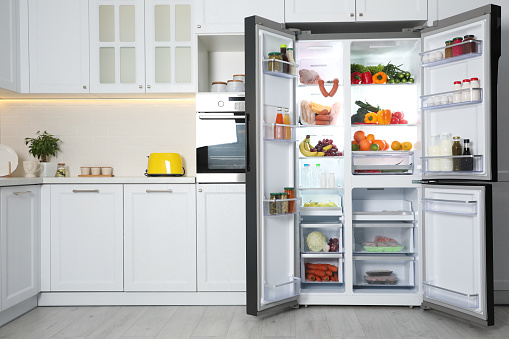Want to do Norcold marine refrigerator troubleshooting? If your Norcold marine refrigerator is not working properly, you may be able to troubleshoot and fix the problem yourself. Keeping your fridge in tip-top shape will ensure that your food stays fresh and your drinks stay cold.
Before you begin any type of troubleshooting, it is important to make sure that the fridge is properly plugged in and that there is power running to it.
If the fridge still does not work after checking these things, then you can begin to look into other potential issues.
How Do You Diagnose a Refrigerator Problem?
There are a few ways that you can diagnose a refrigerator problem. One way is to simply listen to the fridge. If you hear a humming noise, then the fridge is probably running properly.
However, if you hear a clicking noise, this could indicate that there is an issue with the compressor.
Another way to diagnose a refrigerator problem is to feel the exterior of the fridge. If the sides of the fridge are warm, this could mean that the compressor is not running properly.
Additionally, if you notice condensation or frost on the inside of the fridge, this could be an indication that there is a problem with the seals.
Here are some common Norcold marine refrigerator troubleshooting tips:
PROBLEM 1: Puddling Water on the Floor
If you notice water puddling on the floor near your fridge, this could be a sign of a problem with the door seal. Inspect the seal to see if it is cracked or damaged in any way.
If the seal is damaged, it will need to be replaced.
PROBLEM 2: Not Cooling Properly
If your fridge is not cooling properly, there are a few things that could be causing the problem. First, check to see if the fridge is set to the correct temperature. If it is, then you may need to clean the condenser coils. Dirty coils can cause the fridge to work harder to stay cool, which can lead to problems.
To clean the coils, simply unplug the fridge and use a brush or vacuum to remove any dirt or debris.
PROBLEM 3: Ice Buildup
If you notice ice buildup on the shelves or inside of the fridge, this could be a sign of a problem with the defrost timer. The timer controls how often the fridge goes through the defrost cycle.
If it is not working properly, it can cause ice to build up. To fix this problem, you will need to replace the timer.
PROBLEM 4: Fridge is Noisy
If your fridge is making strange noises, there could be a problem with the condenser fan. The fan helps to circulate air and keep the fridge cool.
If it is not working properly, it can cause the fridge to be noisy. To fix this problem, you will need to replace the fan.
PROBLEM 5: Lights are Not Working
If the lights inside your fridge are not working, there could be a problem with the light bulb. First, check to see if the bulb is burned out. If it is, simply replace it with a new one.
If the light still does not work, there could be a problem with the light switch. To test the switch, you will need to use a multimeter.
PROBLEM 6: Too Much Moisture Inside the Fridge
If you notice excess moisture inside the fridge, there could be a problem with the door seal.
Inspect the seal to see if it is cracked or damaged in any way. If the seal is damaged, it will need to be replaced.
PROBLEM 7: Door Does Not Close or Seal Properly
If the door to your fridge does not close or seal properly, there could be a problem with the door gasket. The gasket helps to create a seal around the door. If it is damaged, it will need to be replaced.
PROBLEM 8: Water Dispenser Not Working
If the water dispenser on your fridge is not working, there could be a problem with the waterline. First, check to see if the water line is properly connected to the fridge.
If it is, then you will need to replace the water filter. A clogged water filter can cause the dispenser to stop working.
Know When to Call In a Professional
These fixes are great for simple problems, but sometimes you need a little extra help. If your fridge is still not working after trying these troubleshooting tips, then it may be time to call in a professional.
A qualified technician will be able to diagnose and fix the problem quickly and efficiently. Call in reinforcements if:
- the condenser coils are damaged
- the fridge is not cooling properly and you have cleaned the coils
- the ice buildup is excessive
- the noise persists after replacing the condenser fan
- the lightbulb and switch have been replaced but the light still does not work
- the door gasket needs to be replaced
FAQs About Refrigerator Troubleshooting
Q. How do I level my refrigerator?
Use a level to check if your refrigerator is level from front to back and side to side. If it’s not, adjust the leveling legs until it is.
Q. How cold should my refrigerator be?
The ideal temperature for a refrigerator is between 35°F and 40°F.
Q. How often should I clean my refrigerator coils?
It’s a good idea to clean your coils every three to six months.
Q. Does my refrigerator need annual maintenance?
While annual maintenance is not required, it’s a good idea to have your fridge checked by a professional every year to ensure it’s running properly.
Q. Where can I find the wiring diagram for my refrigerator?
The wiring diagram should be located on the inside of the fridge, near the control panel. If you can’t find it there, check your owner’s manual.
Final Thoughts
Your refrigerator is one of the most important appliances in your home. It keeps your food fresh and your drinks cold. So, when it’s not working properly, it can be a real pain. Thankfully, there are a few things you can do to troubleshoot and fix common fridge problems.
By following these tips, you can get your fridge back up and running in no time.
Do you have any other tips for refrigerator troubleshooting? Share them in the comments below!


